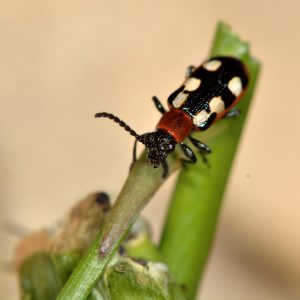Asparagus beetle (Crioceris asparagi) is a small beetle that affects vegetable asparagus, but not ornamental Asparagus species.
Symptoms

Affected plants may have crooked spears and chewed bark and foliage which can dry up and turn yellowish brown. You will also see the beetles and/or their grubs on the plant. The beetles emerge from the soil in late spring and lay their eggs on the stems and leaves. They are most active from May to September. Even if the infestation is after the cropping season, action is needed as the damage they do can weaken the plant and affect the crop the following year.
Eggs
The eggs are black and elongated and attach to the both spears and leaves of the plant by their end. The eggs will not harm the plant but he more you can get rid of, the fewer beetles will be produced. They hatch in about a week. Size: 1/16" (1.5mm) long
Grubs

The grubs are creamy black in colour with 3 pairs of legs toward the head. There are two generations between late spring and early autumn. They feed on the plants for around two weeks before falling to the ground and pupating in the soil. Size: 3/8" (8-10mm) long
Adults
After pupating in the soil for about a week the adults emerge. The adults are easy to spot as they are black with 6 creamy white patches on their wing cases and a reddish thorax (see photo above). The beetles overwinter in the soil and they can fly so will re-infest the plants from nearby if not disposed of. Size: 1/4" (6-8mm) long
Control
A light infestation will not affect future cropping and it is perfectly possible to pick the grubs and adults off by hand if you have a smallish asparagus bed. Drop the beetles into a bucket of soapy water so they drown. Going forward, cut back the old stems in autumn and burn them to get rid of overwintering beetles. Also, clear up the bed so there is no leaf litter for them to live in. In the unlikely event that you have a severe infestation and can't combat it with hand removal then it can be sprayed with the organic insecticide pyrethrum. Avoid doing this when the plants are in flower though as this can harm pollinators such as bees.
Other Asparagus Pests & Diseases
Crown Rot If you don’t support the foliage, then as the wind blows the stems they can create a funnel shape in the soil around them which channels water to the crowns and can lead to crown rot. So if weather is particularly windy you may wish to watch out for this and support the leaves.
Spotted Asparagus Beetle

(Crioceris duodecimpunctata) Like the common Asparagus Beetle the Spotted variety lay eggs on asparagus, feed on it - often on the berries - but they do less damage. They arrive in the garden slightly later in the spring, so the adults have less opportunity to feed on the spears, and they only lay eggs on the foliage. Because the larvae feed mostly on the berries instead of the foliage, it doesn’t affect the plant’s health as much. Violet Root Rot This is very bad news. It is a distinctive purple looking mould and there is no known cure. The only solution is to burn affected plants. Wet soil exacerbates this fungus so improve drainage in the bed before considering replanting. Slugs & Snails These can nibble the tips as they come up so use the usual methods such as Slug traps to keep them away. If slugs and snails are a real problem then check out our recent blog post on them Pests & Diseases: Slugs & Snails Aphids Both the Potato-Aphid (Macrosiphum Euphorbiae) and the Melon-Cotton aphid (Aphis gossypii) are fond of asparagus. Try to remove them if possible as they will weaken the plant and may even infect it with Asparagus Virus. The virus has no obvious symptoms but it weakens the plant and makes it more susceptible to other pathogens
Growing Tips
For more tips and tricks on growing asparagus have a read of our Grow At Home: Asparagus blog

